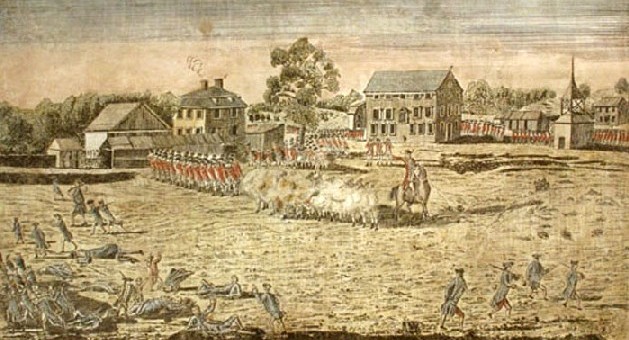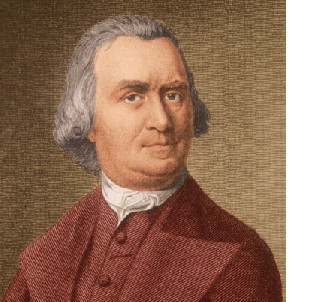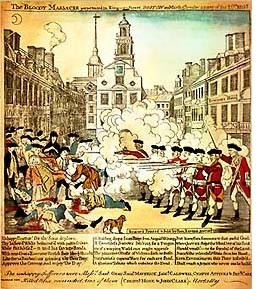Studying history does not ensure that you will get the truth, but it does not surprise me that they were involved in it. As we see today, it was a financially successful financial gain for the bankers to ensure our freedom and now they are doing the same thing to the Chinese.
They, and Brazil are next on the ptb's wealth extraction journey. It will be a lot easier with them since they are used to slave wages and working conditions. Its only the Europeans and Americans that were so uppity as to believe they were worth more than just room and board. Enjoy the journey.
"Battle of Lexington" (1775) -- America's First False Flag?
http://henrymakow.com/2015/04/Was-1775-Battle-of-Lexington-a-False-Flag.html#sthash.XUOrfp7C.dpuf
By James Perloff, Henry Makow publication, April 19, 2015
 (1775 depictions show Americans being slaughtered. No one is even firing back.)
(1775 depictions show Americans being slaughtered. No one is even firing back.)Today is the 240th Anniversary of The "Battle of Lexington."
The "Battle of Lexington," 1775, was portrayed as an unprovoked slaughter of colonists by the British. James Perloff believes that, like the sinking of the USS Maine and 9-11, the event was engineered to start a war, the American Revolution.
 (1775 depictions show Americans being slaughtered. No one is even firing back.)
(1775 depictions show Americans being slaughtered. No one is even firing back.) Today is the 240th Anniversary of The "Battle of Lexington."
The "Battle of Lexington," 1775, was portrayed as an unprovoked slaughter of colonists by the British. James Perloff believes that, like the sinking of the USS Maine and 9-11, the event was engineered to start a war, the American Revolution.
It seems Americans have been manipulated into fighting wars from the get-go.
I grew up in Lexington, Massachusetts, where on April 19, 1775, a force of British redcoats, on their way to Concord to confiscate rebel munitions, encountered a small force of militiamen. Suddenly, "the shot heard round the world" was fired. In the ensuing skirmish, eight colonists were killed, and nine wounded. The British suffered one wounded. This was a causus bellum for the American Revolution.
But, was "the shot heard round the world" a false flag like 9-11, a pretext for war?
As explained in detail my online article The Secrets Buried at Lexington Green, Americans were deceived. It was proclaimed everywhere that the British had committed an unprovoked massacre in Lexington. The truth is individuals in concealed locations fired on the British first.
 Though most Americans today recognize him only as a face on beer bottles, the revolution's mastermind in Massachusetts was Sam Adams, whom biographer John Miller called the "pioneer in propaganda."
Though most Americans today recognize him only as a face on beer bottles, the revolution's mastermind in Massachusetts was Sam Adams, whom biographer John Miller called the "pioneer in propaganda."Adams, left, Temporary Secretary of the 1774 Philadelphia Congress, had secured a pledge from delegates that, should warfare erupt between Massachusetts and British troops, the other colonies would aid Massachusetts. But this carried a stipulation: They would only help IF THE BRITISH FIRED FIRST.
By mid-April 1775 the SECOND Continental Congress was 3 weeks away. Sam Adams desperately needed a "British fired first" incident to bring to the Congress, lest passions for revolution and war wane.
Here is a HIGHLY condensed summary of my article.
• Artists' depictions of the battle gradually evolved--from showing all colonists retreating, to all defiantly resisting.
• The original 1775 depiction [above] represented how Massachusetts rebels wanted the event then portrayed: unprovoked slaughter. The newspaper MASSACHUSETTS SPY denied the militia fired ANY shots, even retaliatory. In their depositions, no Lexington militiaman expressly admitted firing shots.
• As 50th anniversary celebrations approached, the truth began emerging. Residents of neighboring Concord boasted their town should be credited with firing "the shot heard round the world." The outraged Lexington's denizens insisted the honor was theirs. They obtained new depositions from the Lexington battle's aged veterans. In a turnaround, deponents now insisted, they fired at the British, though claiming the redcoats BEGAN hostilities.
• British reports that the Americans fired first are credible. Since the British admitted shooting first at the subsequent Concord battle, why lie about Lexington? Redcoats said the Americans fired first in diaries not intended for publication. And the militiamen amending their depositions weakens their credibility.
 • The night before the battle, Joseph Warren dispatched Paul Revere on his famous ride from Boston. Warren sent another rider, William Dawes, and both arrived at the Lexington house where John Hancock (left) and Samuel Adams--leaders of the revolution in Massachusetts---were staying. Adams had recruited smuggler John Hancock, wealthiest man in Massachusetts, to be the revolution's financial angel.
• The night before the battle, Joseph Warren dispatched Paul Revere on his famous ride from Boston. Warren sent another rider, William Dawes, and both arrived at the Lexington house where John Hancock (left) and Samuel Adams--leaders of the revolution in Massachusetts---were staying. Adams had recruited smuggler John Hancock, wealthiest man in Massachusetts, to be the revolution's financial angel.What history books omit: Warren was Grand Master of St. Andrew's Freemasonic Lodge in Boston; Revere, Dawes and Hancock belonged to that Lodge. After the war, Revere became Grand Master of the Grand Lodge of Massachusetts.
• During the French and Indian War, colonists and redcoats fought on the same side. Britain's national debt nearly doubled by the war's end (1763), and Parliament felt British taxpayers should not bear it alone. It felt colonists should contribute since they were the war's main beneficiaries. Britain's willingness to repeal each revenue measure (Sugar Act, Stamp Act, Townsend Acts) shows more amenability toward colonial protests than commonly believed.
• Adams was instrumental in changing Americans' perception of redcoats to "the bad guys." Adams became Boston's virtual dictator, controlling it through organized mobs. "Tories" (British loyalists) had their homes looted and even destroyed, and their bodies tarred and feathered. These mobs could not be brought to justice. Massachusetts governor Thomas Hutchinson said he doubted if there was "a man of greater malignity of heart, or who less scruples [in using] any measure ever so criminal to accomplish his purposes" than Sam Adams.
• Contrary to what Americans were told, British troops came to Boston in 1768 to restore order. Captain Evelyn wrote his clergyman father in England: "Our arrival has in a great degree restored that liberty they have been so long deprived of, even liberty of speech and security to their persons and property, which has for years past been at the mercy of a most villainous mob."
 • Adams's antipathy to these troops led to the orchestrated "Boston Massacre" (1770), in which a mob of several hundred attacked nine British soldiers until they fired in self-defense. Collected depositions, and Paul Revere's infamously misrepresentative print, portrayed it as unprovoked slaughter of innocents.
• Adams's antipathy to these troops led to the orchestrated "Boston Massacre" (1770), in which a mob of several hundred attacked nine British soldiers until they fired in self-defense. Collected depositions, and Paul Revere's infamously misrepresentative print, portrayed it as unprovoked slaughter of innocents.• At the soldiers' trial, Sam Adams's cousin (and future President) John led the defense. Thirty eight witnesses testified there had been a plot to attack the redcoats. On his deathbed, mortally wounded Patrick Carr forgave the soldier who shot him, as he had done so in self-defense. Enraged, Sam Adams declared the confession should be disregarded because Carr was a "Papist."
• By 1773, England eliminated all taxes on America save a nominal duty on tea of 3 pennies per pound. This tea was so cheap, it undersold the tea John Hancock was smuggling in. The Boston Tea Party conveniently destroyed the merchandise of Hancock's competition.
• Parliament ordered Boston harbor closed until the damage was paid for. Sam Adams blocked all efforts to pay for the tea while warning other colonies: "This attack, though made immediately upon us, is doubtless designed for every other colony."
THE BATTLE OF LEXINGTON
• What a coincidence: The night before the Lexington battle, Adams, Hancock and Revere--apparent mastermind and chief propagandists of the "Boston Massacre"--met in a house a few hundred feet behind Lexington Green. Early that morning, Adams and Hancock walked to the green and spoke to the militiamen at Buckman's tavern.
 (Post war 1886 depiction; what a contrast to 1775's!)
(Post war 1886 depiction; what a contrast to 1775's!) • Contrary to common sense--and behavior of other militias (who fired behind trees and walls) --the grossly outnumbered Lexington militia stood openly in parade formation. The British, marching into the trap, had no choice but to confront them.
• Based on British reports, more than ten shots were probably fired at them before they began disorderly return fire.
• The opening shots came mostly from men in concealed locations, which set up the militia on the green to absorb the British reaction.
• Testimony exists that the shots were NOT fired by local militiamen, but separate gunmen whose identity remains unknown.
• Paul Revere himself was at the green when the British arrived. Revere said he went with John Lowell (fellow St. Andrew's Freemason) to fetch Hancock's trunk at Buckman's Tavern. British reports said the first shots came from the corner of the tavern, where Revere had been only MOMENTS before.
• Parallels between the Boston and Lexington "massacres" were uncanny: similar artistic depictions, questionable depositions, dishonest newspaper accounts.
• Despite the Minutemen's famed marksmanship, the shots fired on the British at Lexington failed to score one significant hit. My article suggests this may have been intentional--dead redcoats would have spoiled the "massacre" story that helped drive the continent to arms.
Before commenting, I encourage interested readers to see the full article
---------
James Perloff has authored several books, including Truth Is a Lonely Warrior, published this year in both Kindle and paperbound editions. It discusses many other suppressed stories of American and world history.***
----------Related - Makow - Illuminati Created the US to Advance NWO
---------- Harrell Rhome - The Occult Origins of the American Nation
Thanks to Jim, we see that our image of the Revolutionary War is one-sided. Like all other wars, it was contrived as part of the long-term Judeo-Masonic plan for world government tyranny. - See more at: http://www.henrymakow.com/#sthash.XUOrfp7C.dpuf
The article is reproduced in accordance with Section 107 of title 17 of the Copyright Law of the United States relating to fair-use and is for the purposes of criticism, comment, news reporting, teaching, scholarship, and research.
No comments:
Post a Comment